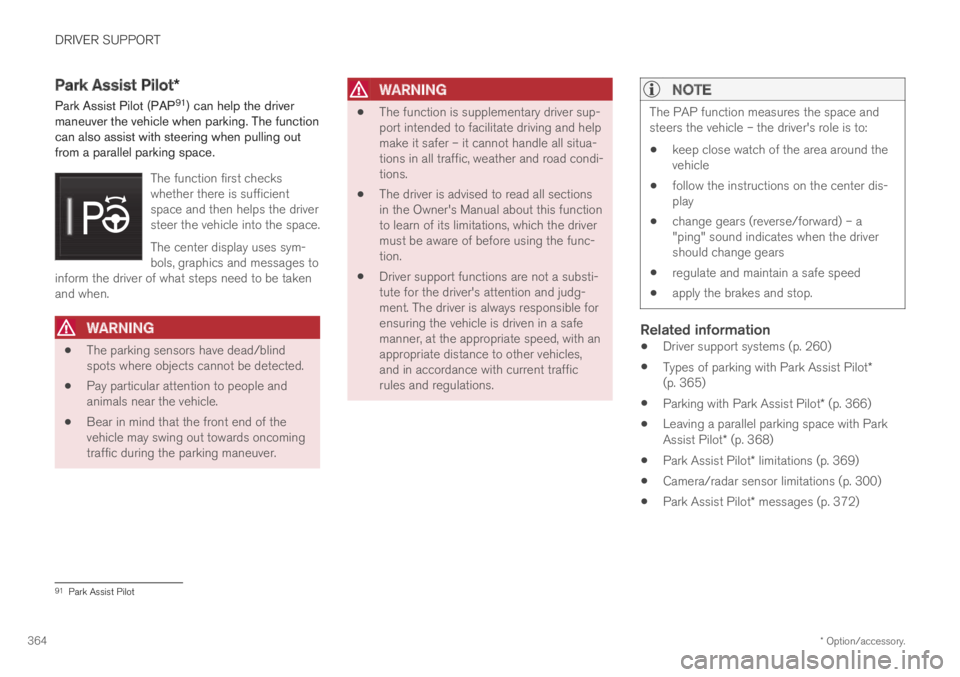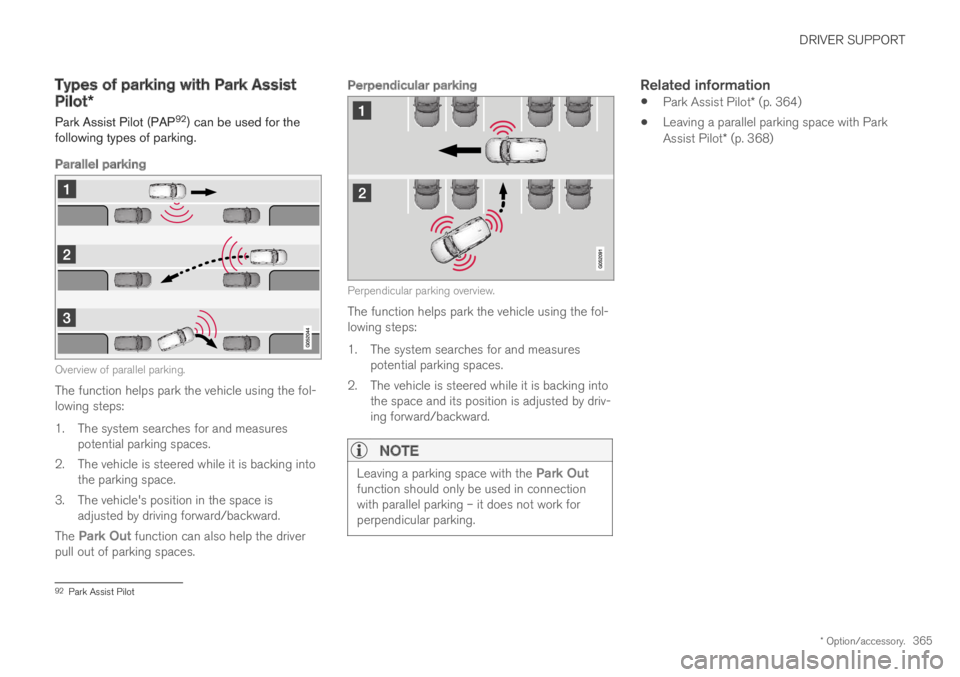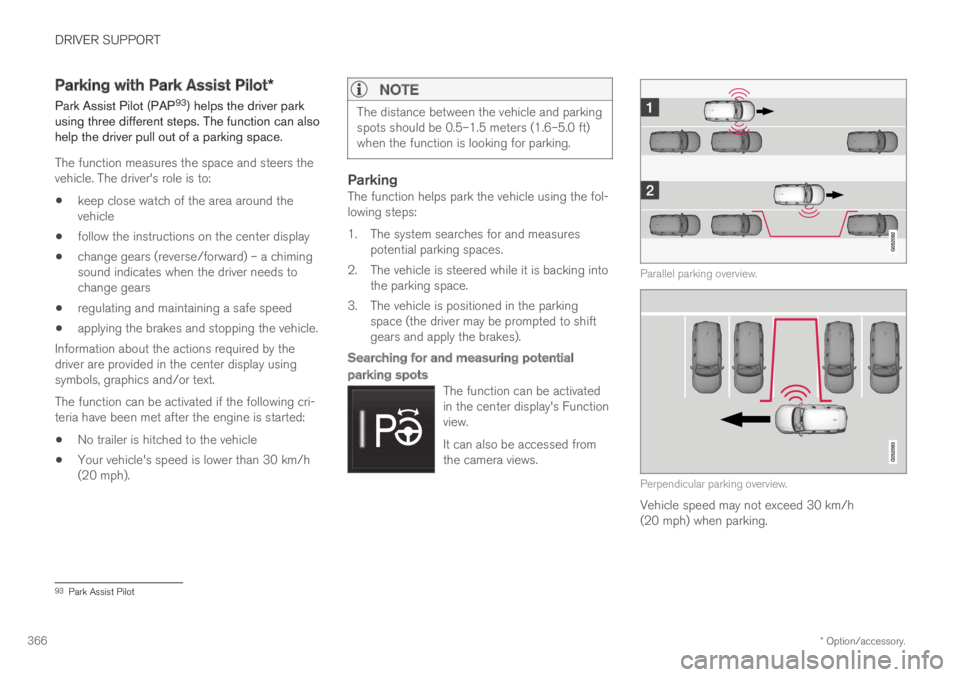2019 VOLVO S60 TWIN ENGINE ESP
[x] Cancel search: ESPPage 366 of 645

DRIVER SUPPORT
* Option/accessory.364
Park Assist Pilot*
Park Assist Pilot (PAP91) can help the drivermaneuver the vehicle when parking. The functioncan also assist with steering when pulling outfrom a parallel parking space.
The function first checkswhether there is sufficientspace and then helps the driversteer the vehicle into the space.
The center display uses sym-bols, graphics and messages toinform the driver of what steps need to be takenand when.
WARNING
The parking sensors have dead/blindspots where objects cannot be detected.
Pay particular attention to people andanimals near the vehicle.
Bear in mind that the front end of thevehicle may swing out towards oncomingtraffic during the parking maneuver.
WARNING
The function is supplementary driver sup-port intended to facilitate driving and helpmake it safer – it cannot handle all situa-tions in all traffic, weather and road condi-tions.
The driver is advised to read all sectionsin the Owner's Manual about this functionto learn of its limitations, which the drivermust be aware of before using the func-tion.
Driver support functions are not a substi-tute for the driver's attention and judg-ment. The driver is always responsible forensuring the vehicle is driven in a safemanner, at the appropriate speed, with anappropriate distance to other vehicles,and in accordance with current trafficrules and regulations.
NOTE
The PAP function measures the space andsteers the vehicle – the driver's role is to:
keep close watch of the area around thevehicle
follow the instructions on the center dis-play
change gears (reverse/forward) – a"ping" sound indicates when the drivershould change gears
regulate and maintain a safe speed
apply the brakes and stop.
Related information
Driver support systems (p. 260)
Types of parking with Park Assist Pilot*(p. 365)
Parking with Park Assist Pilot* (p. 366)
Leaving a parallel parking space with ParkAssist Pilot* (p. 368)
Park Assist Pilot* limitations (p. 369)
Camera/radar sensor limitations (p. 300)
Park Assist Pilot* messages (p. 372)
91Park Assist Pilot
Page 367 of 645

DRIVER SUPPORT
* Option/accessory.365
Types of parking with Park Assist
Pilot*
Park Assist Pilot (PAP92) can be used for thefollowing types of parking.
Parallel parking
Overview of parallel parking.
The function helps park the vehicle using the fol-lowing steps:
1.The system searches for and measurespotential parking spaces.
2. The vehicle is steered while it is backing intothe parking space.
3. The vehicle's position in the space isadjusted by driving forward/backward.
The Park Out function can also help the driverpull out of parking spaces.
Perpendicular parking
Perpendicular parking overview.
The function helps park the vehicle using the fol-lowing steps:
1.The system searches for and measurespotential parking spaces.
2. The vehicle is steered while it is backing intothe space and its position is adjusted by driv-ing forward/backward.
NOTE
Leaving a parking space with the Park Outfunction should only be used in connectionwith parallel parking – it does not work forperpendicular parking.
Related information
Park Assist Pilot* (p. 364)
Leaving a parallel parking space with ParkAssist Pilot* (p. 368)
92Park Assist Pilot
Page 368 of 645

DRIVER SUPPORT
* Option/accessory.366
Parking with Park Assist Pilot*
Park Assist Pilot (PAP93) helps the driver parkusing three different steps. The function can alsohelp the driver pull out of a parking space.
The function measures the space and steers thevehicle. The driver's role is to:
keep close watch of the area around thevehicle
follow the instructions on the center display
change gears (reverse/forward) – a chimingsound indicates when the driver needs tochange gears
regulating and maintaining a safe speed
applying the brakes and stopping the vehicle.
Information about the actions required by thedriver are provided in the center display usingsymbols, graphics and/or text.
The function can be activated if the following cri-teria have been met after the engine is started:
No trailer is hitched to the vehicle
Your vehicle's speed is lower than 30 km/h(20 mph).
NOTE
The distance between the vehicle and parkingspots should be 0.5–1.5 meters (1.6–5.0 ft)when the function is looking for parking.
Parking
The function helps park the vehicle using the fol-lowing steps:
1. The system searches for and measurespotential parking spaces.
2. The vehicle is steered while it is backing intothe parking space.
3. The vehicle is positioned in the parkingspace (the driver may be prompted to shiftgears and apply the brakes).
Searching for and measuring potential
parking spots
The function can be activatedin the center display's Functionview.
It can also be accessed fromthe camera views.
Parallel parking overview.
Perpendicular parking overview.
Vehicle speed may not exceed 30 km/h(20 mph) when parking.
93Park Assist Pilot
Page 371 of 645

DRIVER SUPPORT
}}
* Option/accessory.369
3.Be prepared to stop the vehicle wheninstructed to do so by a graphic and mes-sage in the center display. Follow the instruc-tions in the same way as for the parking pro-cedure.
Note that the steering wheel can "spring" backwhen the procedure is completed and the drivermay need to turn the steering wheel back to themaximum position in order to pull out of the park-ing space.
If the function determines that the driver can pullout of the parking space without any extramaneuvers, the function will be deactivated, evenif it seems as though the vehicle is not com-pletely out of the parking space.
Related information
Park Assist Pilot* (p. 364)
Park Assist Pilot* limitations
Park Assist Pilot (PAP95) may not be able todetect all conditions in all situations and func-tionality may therefore be limited.
WARNING
The parking sensors have dead/blindspots where objects cannot be detected.
Pay particular attention to people andanimals near the vehicle.
Bear in mind that the front end of thevehicle may swing out towards oncomingtraffic during the parking maneuver.
WARNING
The function is supplementary driver sup-port intended to facilitate driving and helpmake it safer – it cannot handle all situa-tions in all traffic, weather and road condi-tions.
The driver is advised to read all sectionsin the Owner's Manual about this functionto learn of its limitations, which the drivermust be aware of before using the func-tion.
Driver support functions are not a substi-tute for the driver's attention and judg-ment. The driver is always responsible forensuring the vehicle is driven in a safemanner, at the appropriate speed, with anappropriate distance to other vehicles,and in accordance with current trafficrules and regulations.
CAUTION
Objects situated higher than the detectionarea of the sensors are not included when theparking maneuver is calculated, which couldcause the function to swing into the parkingspace too early. Such parking spaces shouldbe avoided for this reason.
95Park Assist Pilot
Page 372 of 645

||
DRIVER SUPPORT
370
The driver should be aware of the following limi-tations for Park Assist Pilot:
The parking sequence is cancelled
A parking sequence will be cancelled if:
The driver moves the steering wheel
The vehicle's speed exceeds 7 km/h(4 mph)
The driver taps Cancel in the center display
When the anti-lock brakes or the Electronicstability control are engaged - e.g. when awheel loses grip on a slippery road
When speed-dependent power steeringwheel resistance is working at reducedpower – e.g. during cooling due to overheat-ing.
A message in the center display will explain whythe parking sequence was cancelled.
CAUTION
Under certain circumstances, the functionmay not be able to find parking spaces – onereason may be that the sensors are disruptedby external sound sources that emit the sameultrasonic frequencies that the system workswith.
Examples of such sources include horns, wettires on asphalt, pneumatic brakes, exhaustnoise from motorcycles, etc.
NOTE
Dirt, ice and snow covering the sensorsreduce their function and can make measure-ment impossible.
Driver responsibility
The driver should keep in mind that the functionis a parking aid ‒ not an infallible fully automaticsystem. The driver must always be prepared totake control and cancel a parking sequence ifnecessary.
There are a number of things to keep in mindwhen parking, including:
The driver is always responsible for determin-ing if the space suggested by the function issuitable for parking.
Do not use the function when using snowchains or a temporary spare tire.
Do not use the function if there are anyobjects protruding from the vehicle.
Heavy rain or snowfall may inhibit PAP's abil-ity to accurately measure a parking space.
While searching and measuring the parkingspace, the function may be unable to detectobjects located far into the space.
PAP may not suggest parking spaces onnarrow streets if it does not detect sufficientspace for maneuvering the vehicle.
Use approved tires96 inflated to the correcttire pressure because this affects the func-tion's ability to provide parking assistance.
The function is based on the way the vehi-cles are parked behind and in front of yourparking space. If they are, for example,parked too close to the curb, there is a riskthat your vehicle's tires or wheel rims couldbe damaged by the curb during the parkingprocedure.
96"Approved tires" refers to tires of the same type and make as the vehicle's original, factory-installed tires.
Page 376 of 645

HYBRID INFORMATION
374
General information about TwinEngine
Twin Engine vehicles are driven just like anyother vehicle, but certain functions differ from avehicle powered exclusively by gasoline. Theelectric motor powers the vehicle primarily at lowspeeds; the gasoline engine is used at higherspeeds or during more active driving.
The instrument panel displays Twin Engine-spe-cific information - charging information, selecteddrive mode, distance to discharged battery andhybrid battery charge level.
Different drive modes can be selected while driv-ing, e.g. electric power only or, if more power isneeded, a combination of electric and gasolinepower. The vehicle calculates the optimal combi-nation of driveability, driving experience, environ-mental impact and fuel economy for the selecteddrive mode.
In order to function optimally, the hybrid battery(and its electrical drive systems) and the gasolineengine (and its drive systems) must be at thecorrect operating temperature. Battery capacitycan be considerably reduced if the battery is toocold or too hot. Preconditioning prepares thevehicle's drive systems and passenger compart-ment before driving to help reduce both wear andenergy consumption. It also helps increase thehybrid battery's range.
The hybrid battery which powers the electricmotor is recharged using the charging cable. It
can also be recharged during light braking andthrough engine braking in gear position B. Thecombustion engine can also help recharge thehybrid battery.
Important
No electrical current
Keep in mind that if there is no electrical currentto the vehicle, i.e. the ignition is switched off orthe start battery is discharged, certain functionssuch as brakes, power steering, etc. will not work.
WARNING
If the vehicle does not have electrical currentand both the electric motor and the gasolineengine are switched off, the brakes cannot beused to stop the vehicle.
Towing not permitted
Never tow a Twin Engine vehicle behind anothervehicle, as this could damage the electric motor.
Exterior engine noise
WARNING
Please be aware that there is no sound fromthe engine when the vehicle is being poweredby the electric motor and it may be difficult todetect by children, pedestrians, cyclists andanimals. This is especially true at low speeds.
High-voltage electrical current
WARNING
A number of electrical components in TwinEngine Plug-in Hybrid vehicles use high-volt-age current and can be extremely dangerousif handled incorrectly. These components andany orange wiring in the vehicle may only behandled by trained and qualified Volvo servicetechnicians.
Do not touch anything that is not clearly descri-bed in this Owner's Manual.
Related information
Charging the hybrid battery (p. 375)
Hybrid gauge (p. 85)
Drive modes (p. 412)
Starting and stopping preconditioning(p. 218)
Hybrid battery (p. 578)
Factors affecting electric motor range(p. 421)
Page 395 of 645

STARTING AND DRIVING
}}
393
In some situations, such as in cold weather or ifthe hybrid battery's charge level is too low, thegasoline engine will start instead.
The vehicle should not be started with the charg-ing cable connected. However, if the cable can-not be pulled out or if the vehicle incorrectlydetects a cable that is not connected, the vehiclecan be started using an override procedure:
1.Press the brake pedal and turn the startknob clockwise.
2.Charge cable Remove before start willappear in the instrument panel.
3.Turn the start knob clockwise again.
4.Removed? Turn and hold start knob 7swill appear. Turn the knob clockwise and holdit for 7 seconds to start the vehicle.
Location of the backup reader in the tunnel console.
If the Vehicle key not found message is shownin the instrument panel at start, place the remotekey at the backup reader and then make a newstart attempt.
NOTE
When the remote key is placed in the backupreader, make sure that no other vehicle keys,metal objects or electronic devices (e.g. cellu-lar phones, tablets, laptops or chargers) are inthe backup reader. Multiple vehicle keys closeto each other in the backup reader can dis-rupt their functionality.
If Vehicle start System check, wait is dis-played in the instrument panel while attemptingto start the vehicle, wait until the message disap-pears and try again to start the vehicle.
CAUTION
If the engine has not responded after 3attempts – wait for 3 minutes before startinga new attempt. Starting capability increases ifthe starter battery is given time to recover.
NOTE
The vehicle cannot be started if the hybridbattery is discharged.
WARNING
Never remove the remote control key fromthe vehicle while driving.
WARNING
Always remove the remote key from thepassenger compartment when you leavethe vehicle and make sure the ignition isin mode 0.
Always put the gear selector in P andapply the parking brake before leavingthe vehicle. Never leave the vehicle unsu-pervised while the engine is running.
Always open the garage door fully andmake sure that ventilation is very goodbefore starting the engine in a garage.The exhaust fumes produced by the vehi-cle contain carbon monoxide, which isinvisible and odorless but very toxic.
NOTE
With a cold start, idling speed may be consid-erably higher than normal for certain enginetypes. This is done to get the emissions sys-tem up to normal operating temperature asquickly as possible, which minimizes exhaustemissions and protects the environment.
Page 412 of 645

STARTING AND DRIVING
410
The kickdown function
Kickdown can be used when maximum accelera-tion is needed, e.g. when passing.
When the accelerator pedal is depressed all theway to the floor (past the normal full acceleratorposition), the transmission will automaticallyengage kickdown, i.e. immediately shift down to alower gear.
If the accelerator pedal is released from the kick-down position, the transmission will automaticallyshift up again.
Safety function
The transmission control module is equipped witha downshift protection feature to help prevent theengine from overheating.
In some conditions, the transmission will preventdownshifting/kickdown if this would lead to suchhigh engine speed (rpm) that the engine couldbe damaged. If the driver still attempts downshift-ing or kickdown at a high rpm, nothing will hap-pen and the original gear will remain selected.
With kickdown, the vehicle can downshift one ormore steps at a time depending on the enginespeed. The vehicle upshifts when the engine rea-ches its maximum rpm to prevent engine dam-age.
Related information
Gear selector positions for automatic trans-missions (p. 406)
All Wheel Drive (AWD)
All-wheel drive (AWD5), also called four-wheeldrive, means that power is distributed to all fourwheels, which improves traction.
The electric motor that powers the rear wheelsenables electronic all-wheel drive functionality.All-wheel drive reacts differently depending onwhich drive mode is selected.
Related information
Drive modes (p. 412)
Transmission (p. 406)
Drive systems
Volvo Twin Engine combines a combustionengine for the front wheels and an electric motorfor the rear wheels.
Two drive systems
Depending on the selected drive mode andpower available in the electric motor, the drivesystems can either be used separately or in tan-dem.
The electric motor gets its energy from a hybridbattery located under the tunnel console. Thehybrid can be charged from a wall outlet or in aspecial charging station. The combustion enginecan also charge the hybrid battery using a specialhigh-voltage generator.
Both the combustion engine and the electricmotor can generate power directly to the wheels.An advanced control system coordinates both thedrive systems to help optimize driving economy.